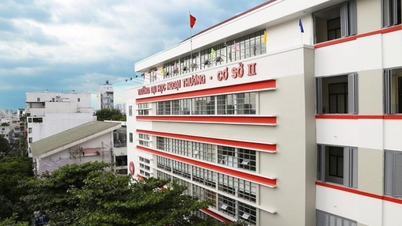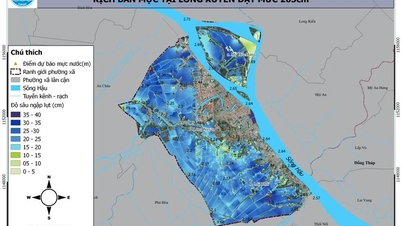With a GDP growth rate of 7.85% in nine months, Vietnam continues to maintain strong and steady growth momentum on the journey to achieve its set goals in a challenging global context.

On October 6, in the context of unpredictable fluctuations in the world and regional economy, Vietnam continued to make its mark with an estimated gross domestic product (GDP) growth rate of 7.85% in the first nine months of 2025 compared to the same period last year. This impressive figure is only lower than the growth rate of 9.44% in the same period in 2022 during the 2011-2025 period. The above data was announced by the General Statistics Office on October 6.
Ms. Nguyen Thi Huong, Director of the General Statistics Office, said that this impressive result was not a coincidence but the combination of a series of flexible macroeconomic policies, the Government 's strong determination and the consensus of the entire population. Accordingly, economic growth in the third quarter reached 8.23%, just after the record growth of 14.38% in the third quarter of 2022, continuing to affirm the recovery momentum of "better month after month, better quarter after quarter" that Vietnam has maintained in the context of global instability.
On that basis, Ms. Huong emphasized that the success of the Vietnamese economy in the past nine months has been reinforced by a series of drastic moves from the political system. With the highest determination to mobilize and unleash all resources for socio-economic development, in a relatively short period of time, the Government has focused on completing a huge amount of work. This includes strongly implementing the revolution in the organization of the Government apparatus, rearranging administrative units at all levels and building a two-level local government organization. Relevant legal regulations have also been amended, supplemented and completed synchronously, especially the regulations on decentralization, delegation of power and division of authority associated with two-level local governments.
Institutional reform efforts, especially in organizational structure and legal framework improvement, have created a much more favorable environment for production and business activities. This is a solid foundation for enterprises, especially the private sector, to maximize their potential.
In addition, Ms. Huong emphasized that the implementation of major Central Resolutions on science and technology development, innovation, national digital transformation, international integration and innovation in law-making and enforcement has added momentum to growth. Activities celebrating major holidays of the year, such as the 80th anniversary of the August Revolution and National Day September 2 with solemn parades and marches, not only arouse national pride but also create a great vitality and motivation for people across the country to continue to strive and achieve socio-economic development goals.
The report from the General Statistics Office noted that ministries, branches and localities have closely monitored the complex fluctuations of the world and domestic economic situation, thereby promptly proposing flexible tasks and solutions to achieve the set goals. This initiative has contributed significantly to maintaining macroeconomic stability and promoting continuous growth.

Growth momentum spreads across economic sectors
According to the Director of the General Statistics Office, the impressive GDP growth results in the first nine months were contributed by the recovery and even development of all three key economic sectors.
Specifically, the agriculture, forestry and fishery sector, despite facing adverse impacts from storms and floods, has maintained stability thanks to timely implementation of measures to respond to and overcome the consequences of natural disasters. The added value of this sector increased by 3.83% in the first nine months, only lower than the growth rate of the same period in 2011, 2018 and 2021. Of which, agriculture increased by 3.46%, forestry increased by 6.46% and fishery increased by 4.48%, contributing 3.52%, 0.42% and 1.41% respectively to the total added value of the whole economy. This demonstrates the high adaptability of the sector, ensuring food security and stabilizing people's livelihoods.
In the industrial and construction sector, production activities of many key industries increased significantly, contributing significantly to the overall growth momentum. In particular, the added value of the entire industrial sector in the first nine months increased by 8.55% over the same period last year, contributing 35.06% to the growth rate of the total added value of the entire economy. In particular, the processing and manufacturing industry continued to be a bright spot and became the main growth driver with a growth rate of 9.92%, contributing up to 31.73%. In addition, the construction industry also recorded a solid growth rate of 9.33%, contributing 7.99%. The strong growth of the processing and manufacturing industry shows the effectiveness of policies to attract investment, improve production capacity and participate more deeply in the global value chain.
In addition, the service sector is equally vibrant with a sharp increase in demand for domestic consumption of goods, services and tourism, especially during major national holidays. This has contributed positively to the growth of the trade and service sector. As a result, the added value of the service sector in the first nine months increased by 8.49% over the same period last year, just lower than the 11.37% increase in the same period in 2022. The service sectors with large proportions all achieved high growth rates: wholesale and retail increased by 8.28% (contributing 10.72%); Transportation and warehousing increased by 10.68% (contributing 8.92%); Financial, banking and insurance activities increased by 7.06% (contributing 5.16%); In particular, accommodation and catering services increased by 10.15% (contributing 3.50%), reflecting the strong recovery of the tourism industry and domestic consumption.
Regarding the nine-month economic structure, the agriculture, forestry and fishery sector accounted for 11.30%, the industry and construction sector accounted for 37.58%, the service sector accounted for 42.92%; and product taxes minus product subsidies accounted for 8.20%. Compared to the same period in 2024, this structure shows a slight shift towards increasing the proportion of the service sector, reflecting the development trend of a modern economy.

Consumption and accumulation are promoted.
Regarding GDP use in the nine months, the report's figures show that both domestic consumption and investment are the main drivers of growth. Of which, final consumption increased by 8.07% compared to the same period in 2024, contributing 73.83% to the overall growth rate of the economy. This shows stable purchasing power and people's confidence in the economy. Along with that, asset accumulation also increased by 8.52%, contributing 41.43%, reflecting an increase in public and private investment activities, creating a foundation for production capacity and sustainable development in the future.
Foreign trade activities also maintained positive growth momentum. Exports of goods and services increased by 15.51%, while imports of goods and services increased by 16.75%.
Regarding international economic developments, the Head of the General Statistics Office shared that the global economy continues to be complex and unpredictable. Strategic competition between major countries is increasingly fierce, trade tensions, military conflicts and political instability in some regions are still widespread and prolonged, affecting the prospects for global economic growth. In addition, natural disasters and climate change have caused serious consequences and challenges to energy security and food security are increasing.
However, the international economy also recorded significant positive signals. Specifically, the global financial situation became more favorable when the actual US tariff policy was lower than initially announced and inflation continued to decline. The stock market was relatively active with the S&P 500 index reaching an all-time high in July 2025, thanks to information related to tariffs and macroeconomic data released "better than expected". Moreover, bank credit growth continued to recover and capital flows into developing economies improved. Accordingly, the issuance of non-financial corporate bonds and government bonds reached a high level.
In response to these developments, Ms. Huong said that most international organizations (such as the Organization for Economic Cooperation and Development - OECD, the United Nations, Fitch Rating and the International Monetary Fund - IMF) have slightly increased their forecasts for global economic growth in 2025 compared to previous forecasts, reflecting the recovery of export-oriented production and growth-promoting policies of several major economies.
Notably, while many regional economies have seen their growth forecasts revised downward, Vietnam has seen its own positive signs. In September, the Asian Development Bank (ADB) forecast Vietnam’s economic growth in 2025 to reach 6.7%, 0.1 percentage points higher than its forecast in April. Although the World Bank (WB) and the International Monetary Fund (IMF) forecast Vietnam’s growth in 2025 to be slightly lower than in 2024 (6.6% and 6.5%, respectively), these figures are still among the top in the region and globally, demonstrating the stability and attractiveness of Vietnam’s investment environment./.
Source: https://baolangson.vn/gdp-chin-thang-tang-7-85-ket-qua-cua-hang-loat-chinh-sach-vi-mo-linh-hoat-5060953.html




































































































Comment (0)